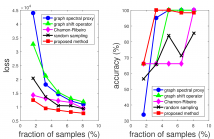
ICASSP is the world’s largest and most comprehensive technical conference focused on signal processing and its applications. The 2019 conference will feature world-class presentations by internationally renowned speakers, cutting-edge session topics and provide a fantastic opportunity to network with like-minded professionals from around the world. Visit website.

- Read more about PARAMETER ESTIMATION OF HEAVY-TAILED RANDOM WALK MODEL FROM INCOMPLETE DATA
- Log in to post comments
- Categories:
 3 Views
3 Views
- Read more about Data-Driven Nonparametric Hypothesis Testing
- Log in to post comments
- Categories:
 21 Views
21 Views
- Read more about SINGLE CHANNEL SPEECH SEPARATION WITH CONSTRAINED UTTERANCE LEVEL PERMUTATION INVARIANT TRAINING USING GRID LSTM
- Log in to post comments
Utterance level permutation invariant training (uPIT) tech- nique is a state-of-the-art deep learning architecture for speaker independent multi-talker separation. uPIT solves the label ambiguity problem by minimizing the mean square error (MSE) over all permutations between outputs and tar- gets. However, uPIT may be sub-optimal at segmental level because the optimization is not calculated over the individual frames. In this paper, we propose a constrained uPIT (cu- PIT) to solve this problem by computing a weighted MSE loss using dynamic information (i.e., delta and acceleration).
- Categories:
 86 Views
86 Views
- Read more about On the Supermodularity of Active Graph-based Semi-supervised Learning with Stieltjes Matrix Regularization
- Log in to post comments
Active graph-based semi-supervised learning (AG-SSL) aims to select a small set of labeled examples and utilize their graph-based relation to other unlabeled examples to aid in machine learning tasks. It is also closely related to the sampling theory in graph signal processing. In this paper, we revisit the original formulation of graph-based SSL and prove the supermodularity of an AG-SSL objective function under a broad class of regularization functions parameterized by Stieltjes matrices.
- Categories:
 83 Views
83 Views
- Read more about Semidefinite Programming for TDOA Localization with Locally Synchronized Anchor Nodes
- Log in to post comments
The most state-of-art time-difference-of-arrival (TDOA) localization algorithms are performed under the assumption that all the nodes are synchronized. However, for a widely distributed wireless sensor networks (WSNs), time synchronization between all the nodes is not a trival problem. In this paper, we study the problem of source localization using signal TDOA measurements in the system of nodes part synchronization. Starting from the maximum likelihood estimator (MLE), we develop a semidefinite programming (SDP) approach.
- Categories:
 29 Views
29 Views
- Categories:
 27 Views
27 Views
- Read more about NEURAL NETWORK LANGUAGE MODELING WITH LETTER-BASED FEATURES AND IMPORTANCE SAMPLING
- Log in to post comments
In this paper we describe an extension of the Kaldi software toolkit to support neural-based language modeling, intended for use in automatic speech recognition (ASR) and related tasks. We combine the use of subword features (letter ngrams) and one-hot encoding of frequent words so that the models can handle large vocabularies containing infrequent words. We propose a new objective function that allows for training of unnormalized probabilities. An importance sampling based method is supported to speed up training when the vocabulary is large.
- Categories:
 50 Views
50 Views
- Read more about A Pruned RNNLM Lattice-Rescoring Algorithm for Automatic Speech Recognition
- Log in to post comments
Lattice-rescoring is a common approach to take advantage of recurrent neural language models in ASR, where a wordlattice is generated from 1st-pass decoding and the lattice is then rescored with a neural model, and an n-gram approximation method is usually adopted to limit the search space. In this work, we describe a pruned lattice-rescoring algorithm for ASR, improving the n-gram approximation method. The pruned algorithm further limits the search space and uses heuristic search to pick better histories when expanding the lattice.
- Categories:
 37 Views
37 Views
- Read more about CALIBRATING CAMERAS IN POOR-CONDITIONED PITCH-BASED SPORTS GAMES
- Log in to post comments
- Categories:
 12 Views
12 Views